Local Governance of Groundwater Resources through the Lens of Stakeholders in the Context of State-Led Management in the Lower Mekong Region
Abstract
:1. Introduction
2. Materials and Methods
2.1. Study Area
2.2. Data Collection
2.3. Data Analysis
3. Results
3.1. GWG Performance through the Lens of Different Stakeholders
3.1.1. Effectiveness
3.1.2. Efficiency
3.1.3. Trust and Engagement
3.2. Local GWG Model
- Effectiveness—(i) existing analytical reports about GW management (ERG) (β = 0.85), (ii) policy coherence (PC) (β = 0.83), and (iii) institutional capacity (IC) (β = 0.82).
- Efficiency—(i) bottom-up approach (BUA) (β = 0.84) and (ii) GW information systems (GWI) (β = 0.82) have the highest factor loadings in this dimension. Both indicators can explain the efficiency (EFFI) of GWG in this case.
- Trust and engagement—(i) legal frameworks related to stakeholder participation (LSH) (β = 0.89) and (ii) corruption monitoring (CM) (β = 0.85) and (iii) legal frameworks related GW user equality (LFU) (β = 0.85) have strong explanation to the trust and engagement dimension.
4. Discussion
5. Conclusions
Author Contributions
Funding
Institutional Review Board Statement
Informed Consent Statement
Data Availability Statement
Acknowledgments
Conflicts of Interest
Appendix A
| Dimension/Principles (Latent Variables) | Indicators (Observed Variables) | Label |
|---|---|---|
| Effectiveness | ||
| 1. Clear roles and responsibilities | 1.1 The level of implementation of groundwater laws and regulations (Groundwaters Act 1992). | GPI |
| 1.2 Ministry of Natural Resources and Environment, Department of Groundwater Resources and Bureau of Groundwater Resources Region 4 (Khon Kaen) approached to manage groundwater resources in Khon Kaen. | GRA | |
| 1.3 The existing of forms of analytical reports, regulatory impact assessments, or regulatory reviews about groundwater management, i.e., open stakeholder consultations. | ERG | |
| 2. Appropriate scales within basin systems | 2.1 The level of implementation of integrated groundwater resource management policies and strategies, i.e., manage groundwater together with surface water. | IGM |
| 2.2 The existence and functioning of institutions managing groundwater at the hydrographic scale, i.e., groundwater basin management or aquifer management. | GWB | |
| 2.3 The level of implementation of cooperation mechanisms for the management of water resources across groundwater users and levels of government from local to basin, regional, national and upper scales, i.e., shared data and information system, joint programs, joint projects or contracts, co-financing, or forms of multi-level dialogue. | CGW | |
| 3. Policy coherence | 3.1 Integrated policies, strategies, fostering coherence across sectors, while minimizing contradictory objectives and negative impacts. | CSP |
| 3.2 Institutions facilitated policies across ministries, managing trade-offs across water, environment, health, energy, agriculture, industry, spatial planning, and land use and other relevant sectors. | IFP | |
| 3.3 The level of implementation of mechanisms to review barriers to policy coherence, i.e., outdated legislation, distortive subsidies, conflicting interests, competition between ministries, overlapping roles and responsibilities, lack of integrated planning, split incentives, or poor enforcement. | PC | |
| 4. Capacity | 4.1 The level of implementation of policies, based on transparent professional and recruitment process of groundwater professionals independent from political cycles, i.e., presence of competent staff able to deal with technical and non-technical water-related issues across agencies and responsible ministries. | TP |
| 4.2 The level of capacity of responsible authorities in carrying out their duties and coping with groundwater challenges. | IC | |
| 4.3 The level of implementation of educational and training programs for groundwater professionals, i.e., educational curricula, executive training, technical assistance, etc., to strengthen the capacity of groundwater institutions as well as stakeholders. | TKD | |
| Efficiency | ||
| 5. Data and information | 5.1 The existence and functioning of updated, timely shared, consistent, and comparable groundwater information systems, i.e., the status of groundwater resources, groundwater financing, environmental needs, socio-economic features, and institutional mapping. | GWS |
| 5.2 The existence of independent data and official groundwater-related statistics at regional and provincial level. | IGR | |
| 5.3 The level of implementation of mechanisms to identify and review data gaps, overlaps, and unnecessary data, i.e., reviews, reports, and open consultations. | EPI | |
| 6. Financing | 6.1 The level of implementation of governance arrangements which help groundwater institutions collect the necessary revenues to meet their mandates and drive sustainable groundwater and efficient behavior (i.e., the polluter pays or conservation pays). | IGT |
| 6.2 The functioning of groundwater institutions exists, and they are in charge of collecting groundwater revenues (taxes and tariffs) and allocating them in a transparent, efficient, and timely manner. | IN | |
| 6.3 The level of implementation of identifying investment needs and funding gaps in terms of physical infrastructure and governance functions to achieve universal coverage of groundwater services. | LF | |
| 7. Regulatory frameworks | 7.1 The level of implementation of a groundwater management regulatory framework to foster enforcement and compliance, achieve regulatory objectives in a cost-effective way, and protect the public interest. | PO |
| 7.2 The functioning of dedicated public institutions responsible for ensuring key regulatory functions for groundwater services and resource management. | RI | |
| 7.3 The level of implementation of regulatory tools, i.e., evaluation and consultation mechanisms, to ensure that rules, institutions, and processes are fit-for-purpose, well-coordinated, cost-effective, transparent, non-discriminatory, participative and easy to understand and to enforce. | IPF | |
| 8. Innovative governance | 8.1 The level of implementation of policy frameworks and incentives fostering innovation in groundwater management practices and processes (i.e., pilots to draw lessons and share experience prior to generalizing a given reform or process at a larger scale). | BUA |
| 8.2 The functioning of institutions encouraging bottom-up initiatives, dialogue and social learning, and experimentation in groundwater management at different levels, i.e., promoting innovative ways to cooperate across government and stakeholders, pool resources, and upscale groundwater governance innovation. | SPI | |
| 8.3 The level of implementation of knowledge and experience-sharing mechanisms to bridge between science, policy, and practice, i.e., multi-stakeholder co-creation processes and tools supporting decision-making processes based on scientific evidence, communicated for example through interactive maps, simulation models, etc. | TDM | |
| Trust and Engagement | ||
| 9. Integrity and transparency | 9.1 The level of implementation of legal and institutional frameworks which hold decision makers and stakeholders accountable on integrity and transparency also apply to groundwater management at large, i.e., the right to information, public procurement, in accordance with best international practice, as well as the transposition of applicable international conventions. | CM |
| 9.2 The functioning of independent courts and supreme audit institutions that can investigate groundwater-related offenses and safeguard the public interest. | LFSH | |
| 9.3 The level of implementation of mechanisms to identify potential drivers of corruption and risks in all groundwater institutions at different levels, as well as other groundwater integrity and transparency gaps, i.e., multi-stakeholder approaches, social witnesses, or social monitoring. | OSH | |
| 10. Stakeholder engagement | 10.1 The level of implementation of legal frameworks to engage stakeholders in the design and implementation of groundwater-related decisions, policies, and projects. | RSH |
| 10.2 The functioning of organizational structures and responsible authorities to engage stakeholders in groundwater-related policies and decisions, i.e., groundwater basin-based authorities, decentralized assemblies, governing boards, national or subnational groundwater councils or committees, as well as informal forms of community-based engagement or groundwater village councils. | LFU | |
| 10.3 The level of implementation of mechanisms to diagnose and review stakeholder engagement challenges, processes, and outcomes, i.e., satisfaction surveys, standards, impact assessment, financial analysis, evaluation reports, or multi-stakeholder workshops/meetings. | OU | |
| 11. Trade-offs across users, rural and urban areas, and generations | 11.1 The level of implementation of formal provisions or legal frameworks fostering equity across water users, rural and urban areas, vulnerable and marginalized groups, and next generations (i.e., human right to drinking water and sanitation, sustainable development goals, new urban agenda, and other forms of incentives). | TU |
| 11.2 The functioning of institutions to protect groundwater users, including vulnerable groups, addressing users’ complaints and managing trade-offs when need be. | PFM | |
| 11.3 The level of implementation of mechanisms or platforms to manage trade-offs across users, or transparent and evidence-based decision-making on trade-offs needed across people (i.e., public debates, rural–urban cooperation, partnerships, projects, etc.) | ICM | |
| 12. Monitoring and evaluation | 12.1 The level of implementation of policy frameworks promoting regular monitoring and evaluation of groundwater policy and governance in order to effectively guide decision making. | PME |
| 12.2 The functioning of institutions in charge of monitoring and evaluation of groundwater policies and practices to produce evidence-based assessment on the performance of groundwater management and governance to support decision making. | GPI | |
| 12.3 The level of implementation of monitoring and evaluation mechanisms to measure to what extent groundwater policy fulfils the intended outcomes and groundwater governance frameworks are suitable (i.e., groundwater governance reviews, national or international assessment). | GRA | |
Appendix B
| Latent Variables | Label | Observed Variables | Label | Standardized Factor Loadings (β) | Standard Error (S.E.) |
|---|---|---|---|---|---|
| Effectiveness | EFFEC | GW policy implementation | GPI | 0.67 | 0.061 |
| GW related authorities | GRA | 0.78 | 0.045 | ||
| Existing analytical reports about GW management | ERG | 0.85 | 0.032 | ||
| Integrated groundwater resource management policies | IGM | 0.77 | 0.046 | ||
| GW basin management/Aquifer management | GWB | 0.55 | 0.048 | ||
| Cooperation for GW management | CGM | 0.79 | 0.043 | ||
| Cross-sectoral policies | CSP | 0.77 | 0.046 | ||
| Institutions facilitated policies across ministries | IFP | 0.80 | 0.041 | ||
| Policy coherence | PC | 0.82 | 0.037 | ||
| Transparent policies | TP | 0.80 | 0.041 | ||
| Institutional capacity | IC | 0.82 | 0.039 | ||
| Training and knowledge dissemination | TKD | 0.76 | 0.048 | ||
| Efficiency | EFFI | GW information systems | GWI | 0.83 | 0.036 |
| GW information and statistical data | GWS | 0.76 | 0.047 | ||
| Information gap reviews | IGR | 0.77 | 0.046 | ||
| Economic policy instruments | EPI | 0.81 | 0.040 | ||
| Institution-related GW tariff | IGT | 0.75 | 0.049 | ||
| Investment needs | IN | 0.74 | 0.051 | ||
| Legal framework | LF | 0.79 | 0.043 | ||
| Public organization | PO | 0.79 | 0.043 | ||
| Regulatory instruments | RI | 0.81 | 0.040 | ||
| Innovation policy framework | IPF | 0.72 | 0.053 | ||
| Bottom-up approach | BUA | 0.83 | 0.035 | ||
| Science–policy interface | SPI | 0.79 | 0.042 | ||
| Trust and Engagement | TEM | Transparency of decision makers | TDM | 0.83 | 0.037 |
| Courts investigate groundwater-related offenses and safeguard the public interest | CGW | 0.75 | 0.050 | ||
| Corruption monitoring | CM | 0.85 | 0.033 | ||
| Legal frameworks related to stakeholder participation | LFSH | 0.89 | 0.025 | ||
| Organization related to stakeholder participation | OSH | 0.84 | 0.034 | ||
| Review stakeholder engagement challenges, processes, and outcomes | RSH | 0.81 | 0.040 | ||
| Legal frameworks related to GW user equality | LFU | 0.85 | 0.033 | ||
| Organization related to GW user protection | OU | 0.77 | 0.047 | ||
| Trade-off across GW users | TU | 0.82 | 0.038 | ||
| Policy frameworks promoting regular monitoring and evaluation of groundwater policy and governance | PFM | 0.79 | 0.042 | ||
| Institutions in charge of monitoring and evaluation of groundwater policies | ICM | 0.79 | 0.042 | ||
| Policy monitoring and evaluation | PME | 0.76 | 0.047 |
References
- IGRAC. Groundwater Overview: Making the Invisible Visible. UN-Water Category III Publication. 2018. Available online: https://www.unwater.org/publications/groundwater-overviewmaking-the-invisible-visible/ (accessed on 6 June 2022).
- UNESCO. Science for a Water Secure World in a Changing Environment. IHP-IX: The Ninth Phase of the Intergovernmental Hydrological Programme 2022–2029. 2021. Available online: https://en.unesco.org/sites/default/files/draft_of_3rd_order_draft_of_ihp-ix_fra_ger.pdf (accessed on 6 June 2022).
- Dam, R.A.; Jayakumar, R.; Surinkum, A.; Pavelic, P.; Johnston, R.; Ansems, N. Groundwater resources in the Greater Mekong Sub-region; collaborative resource management to increase resilience. In Thematic Session “Geoscience for the Society”, 52nd CCOP Annual Session Bangkok, Thailand; 2016; Available online: http://waterlandexperts.nl/wp-content/uploads/2014/12/Groundwater-Lower-Mekong-Basin-Dam-et-al-2016.pdf (accessed on 6 June 2022).
- Le Meur, M.; Le Phu, V.; Gratiot, N. What Is the Future of the Lower Mekong Basin Struggling against Human Activities? A Review. In River Deltas-Recent Advances; IntechOpen: London, UK, 2021. [Google Scholar]
- Ngoc, N.T.M.; Lee, E.; Jayakumar, R. Current Status and Issues of Groundwater in the Mekong River Basin; Ha, K., Ed.; Korea Institute of Geoscience and Mineral Resources (KIGAM): Bangkok, Thailand, 2015; p. 121. [Google Scholar]
- Shrestha, M.; Matheswaran, K.; Polapanich, O.U.; Piman, T.; Krittasudthacheewa, C. A Stakeholder-Centric Tool for Implementing Water Management Strategies and Enhancing Water Cooperation (SDG 6.5) in the Lower Mekong Region. In Water, Climate Change, and Sustainability; 2021; pp. 239–256. Available online: https://onlinelibrary.wiley.com/doi/abs/10.1002/9781119564522.ch16 (accessed on 6 June 2022).
- Xiao, H.; Tang, Y.; Li, H.; Zhang, L.; Ngo-Duc, T.; Chen, D.; Tang, Q. Saltwater intrusion into groundwater systems in the Mekong Delta and links to global change. Adv. Clim. Chang. Res. 2021, 12, 342–352. [Google Scholar] [CrossRef]
- Gupta, A.D.; Shrestha, S.; Nguyen, T.P.L.; KC, S. Towards sustainable groundwater management of transboundary aquifers in the Lower Mekong region. In Proceedings of the THA 2022 International Conference, Online, 26–28 January 2022; Available online: http://project-wre.eng.chula.ac.th/aseanacademicnetwork/files/THA2022/TC/TC-312S.pdf (accessed on 6 June 2022).
- Conti, K.I. Norms in Multilevel Groundwater Governance and Sustainable Development. Ph.D. Thesis, University of Amsterdam, Amsterdam, The Netherlands, 2017. Unpublished. [Google Scholar]
- Linton, J.; Brooks, D.B. Governance of transboundary aquifers: New challenges and new opportunities. Water Int. 2011, 36, 606–618. [Google Scholar] [CrossRef]
- Faysse, N.; Hartani, T.; Frija, A.; Tazekrit, I.; Zairi, C.; Challouf, A. Agricultural use of groundwater and management initiatives in the Maghreb: Challenges and opportunities for sustainable aquifer exploitation. In AFDB Economic Brief; African Development Bank: Tunis, Tunisia, 2011; pp. 1–24. [Google Scholar]
- Jerbi, H.; Massuel, S.; Leduc, C.; Riaux, J.; Tarhouni, J. To What Extent Can Groundwater Uses Affect Long Term Sustainable Exploitation Schemes? Case Study of the Bouhefna-Haffouz Aquifer System (Central Tunisia). In Recent Advances in Environmental Science from the Euro-Mediterranean and Surrounding Regions. EMCEI 2017. Advances in Science, Technology & Innovation (IEREK Interdisciplinary Series for Sustainable Development); Springer: Cham, Switzerland, 2018. [Google Scholar] [CrossRef]
- Bruns, B. Polycentric Solutions for Groundwater Governance in Sub-Saharan Africa: Encouraging Institutional Artisanship in an Extended Ladder of Participation. Water 2021, 13, 630. [Google Scholar] [CrossRef]
- Raja Omar, R.A.A.; Zainuddin, A.; Yusof, R.; Roslan, N.H.; Mickey, A.C. Enhancing Community Groundwater Governance (CGG) model towards innovation Via Good Governance Actors’ Partnership (GGAP). In Proceedings of the 8th International Conference on Public Policy and Social Science (ICoPS) 2021, Lake Tahoe, NV, USA, 12–16 September 2021. [Google Scholar]
- De Stefano, L.; Welch, C.; Urquijo, J.; Garrick, D. Groundwater governance in the Rio Grande: Co-evolution of local and intergovernmental management. Water Altern. 2018, 11, 824–846. [Google Scholar]
- Molle, F.; López-Gunn, E.; van Steenbergen, F. The local and national politics of groundwater overexploitation. Water Altern. 2018, 11, 445. [Google Scholar]
- Molle, F.; Closas, A. Why is state-centered groundwater governance largely ineffective? A review. Wiley Interdiscip. Rev. Water 2020, 7, e1395. [Google Scholar] [CrossRef]
- Pietersen, K.; Beekman, H.E.; Holland, M. South African groundwater governance case study. Final report prepared for the World Bank economic and sector analysis “Improving groundwater governance: The political economy of groundwater policy and institutional reforms. In Partnership with the South African Dept. of Water Affairs and the WRC; 2011; Available online: https://www.wrc.org.za/wp-content/uploads/mdocs/KV%20273-11.pdf (accessed on 6 June 2022).
- Taher, T.; Bruns, B.; Bamaga, O.; Al-Weshali, A.; Van Steenbergen, F. Local groundwater governance in Yemen: Building on traditions and enabling communities to craft new rules. Hydrogeol. J. 2012, 20, 1177–1188. [Google Scholar] [CrossRef]
- Zwarteveen, M.; Kuper, M.; Olmos-Herrera, C.; Dajani, M.; Kemerink-Seyoum, J.; Frances, C.; Beckett, L.; Lu, F.; Kulkarni, S.; Kulkarni, H.; et al. Transformations to groundwater sustainability: From individuals and pumps to communities and aquifers. Curr. Opin. Environ. Sustain. 2021, 49, 88–97. [Google Scholar] [CrossRef]
- Zwickle, A.; Feltman, B.C.; Brady, A.J.; Kendall, A.D.; Hyndman, D.W. Sustainable irrigation through local collaborative governance: Evidence for a structural fix in Kansas. Environ. Sci. Policy 2021, 124, 517–526. [Google Scholar] [CrossRef]
- Calliera, M.; Capri, E. Multi-actor approaches and engagement strategies to promote the adoption of best groundwater management practices. Curr. Opin. Environ. Sci. Health 2022, 27, 100351. [Google Scholar] [CrossRef]
- Wijnen, M.; Augeard, B.; Hiller, B.; Ward, C.; Huntjens, P. Managing the Invisible: Understanding and Improving Groundwater Governance; World Bank: Washington, DC, USA, 2012. [Google Scholar]
- Afruzi, A.; Zare Abyaneh, H.; Abdolabadi, H. Local strategies to manage groundwater depletion under climate change scenarios—A case study: Hamedan-Bahar Plain (Iran). Arab. J. Geosci. 2021, 14, 1–18. [Google Scholar] [CrossRef]
- Dumont, A. Acting Together for the Sustainable Use of Water in Agriculture: Proposals to Prevent the Deterioration and Overexploitation of Groundwater; Éditions AFD: Paris, France, 2021. [Google Scholar]
- Mechlem, K. Groundwater Governance: The Role of Legal Frameworks at the Local and National Level—Established Practice and Emerging Trends. Water 2016, 8, 347. [Google Scholar] [CrossRef]
- Mumma, A.; Lane, M.; Kairu, E.; Tuinhof, A.; Hirji, R. Kenya Groundwater Governance Case Study; Water Papers; World Bank: Washington, DC, USA, 2011; Available online: https://openknowledge.worldbank.org/handle/10986/17227 (accessed on 13 July 2022).
- Tsuyuguchi, B.B. A Social-Ecological Systems Analysis of the Governance of Alluvial Aquifers in the Brazilian Semi-Arid Region: The Case of Sume. Ph.D. Thesis, Universidade Federal de Campina Grande, Paraíba, Brasil, 2021. [Google Scholar]
- Megdal, S.B.; Gerlak, A.K.; Varady, R.G.; Huang, L.Y. Groundwater governance in the United States: Common priorities and challenges. Groundwater 2015, 53, 677–684. [Google Scholar] [CrossRef]
- Closas, A.; Villholth, K.G. Groundwater governance: Addressing core concepts and challenges. Wiley Interdiscip. Rev. Water 2020, 7, e1392. [Google Scholar] [CrossRef]
- Molle, F.; Closas, A. Groundwater metering: Revisiting a ubiquitous ‘best practice’. Hydrogeol. J. 2021, 29, 1857–1870. [Google Scholar] [CrossRef]
- Cheyasit, N.; Kamkiew, W.; Phetsatit, P. The Components of Administration in Accordance with Good Governance of the Department of Groundwater Resources. J. Soc. Dev. 2019, 21, 196–215. [Google Scholar]
- Foster, S. Thailand: Strengthening capacity in groundwater resources management. In World Bank Case Profile Collection; World Bank: Washington, DC, USA, 2008; Volume 1, Available online: https://documents.worldbank.org/en/publication/documents-reports/documentdetail/521371468308952444/thailand-strengthening-capacity-in-groundwater-resources-management (accessed on 13 July 2022).
- Piyapong, J.; Thidarat, B.; Jaruwan, C.; Siriphan, N.; Passanan, A. Enhancing citizens’ sense of personal responsibility and risk perception for promoting public participation in sustainable groundwater resource management in Rayong Groundwater Basin, Thailand. Groundw. Sustain. Dev. 2019, 9, 100252. [Google Scholar] [CrossRef]
- Tanaka, T. Groundwater governance in Asia: Present state and barriers to implementation of good governance. Proc. Int. Assoc. Hydrol. Sci. 2014, 364, 470–474. [Google Scholar] [CrossRef]
- Sarami Froushani, M.; Balal, H.; Movahedi, R. Evaluation of Groundwater Resources Governance Indicators in Iran’s Agricultural Sector: Application of the OECD Governance Framework in the Hamadan-Bahar Plain. Iran. J. Agric. Econ. Dev. Res. 2021, 52, 591–615. [Google Scholar] [CrossRef]
- Jetoo, S. An Assessment of the Baltic Sea action plan (BSAP) using the OECD principles on water governance. Sustainability 2019, 11, 3405. [Google Scholar] [CrossRef]
- Romano, O.; Akhmouch, A. Water governance in cities: Current trends and future challenges. Water 2019, 11, 500. [Google Scholar] [CrossRef]
- Keller, N.; Hartmann, T. OECD water governance principles on the local scale–an exploration in Dutch water management. Int. J. River Basin Manag. 2020, 18, 439–444. [Google Scholar] [CrossRef]
- Johns, C. Water governance indicators in theory and practice: Applying the OECD’s water governance indicators in the North American Great Lakes region. Water Int. 2021, 46, 976–999. [Google Scholar] [CrossRef]
- Muenratch, P.; Nguyen TP, L.; Shrestha, S.; Chatterjee, J.S.; Virdis, S.G. Governance and policy responses to anthropogenic and climate pressures on groundwater resources in the Greater Mekong Subregion urbanizing cities. Groundw. Sustain. Dev. 2022, 18, 100791. [Google Scholar] [CrossRef]
- Chantawongso, P. The 1:50,000 Groundwater Map and Hydrogeological Map of Khon Kaen, Thailand. Technical Report of the CCOP-GSJ Groundwater Project Phase III, 2019. pp. 162–170. Available online: https://www.gsj.jp/data/ccop-gsj/CCOP-GSJ_DOC_GW9_2019.pdf (accessed on 2 July 2022).
- Sudhipongpracha, T.; Dahiya, B. City Profile: Khon Kaen, Thailand. Environ. Urban. ASIA 2019, 10, 271–289. Available online: https://www.adb.org/sites/default/files/publication/185008/urban-development-gms.pdf (accessed on 1 August 2022). [CrossRef]
- Thilakarathne, M.; Sridhar, V. Characterization of future drought conditions in the Lower Mekong River Basin. Weather Clim. Extrem. 2017, 17, 47–58. [Google Scholar] [CrossRef]
- Artlert, K.; Chaleeraktrakoon, C. Modelling and analysis of rainfall processes in the context of climate change for Mekong, Chi, and Mun River Basins (Thailand). J. Hydro-Environ. Res. 2013, 7, 2–17. [Google Scholar] [CrossRef]
- DDPM. The Summary of the Drought Situation in the Responsible Areas of Disaster Prevention and Mitigation Regional Center 6 (DPMRC 6, Khon Kaen). 2016. Available online: http://portal.disaster.go.th/portal/public/index.do#dataTable (accessed on 7 June 2021).
- Sinha, S.; Tripathi, N.K. Assessing the challenges in successful implementation and adoption of crop insurance in Thailand. Sustainability 2016, 8, 1306. [Google Scholar] [CrossRef]
- Van Dau, Q.; Kuntiyawichai, K.; Suryadi, F. Drought severity assessment in the lower Nam Phong River Basin, Thailand. Songklanakarin J. Sci. Technol. 2018, 40, 985–992. [Google Scholar]
- DGR. The Report of the Strategies of 20 Years (2017–2036) Groundwater Management in Thailand. Report. 2017. Available online: http://www.dgr.go.th/th/download/38 (accessed on 18 November 2021).
- DGR. DGR Annual Report 2021. Report. 2021. Available online: http://www.dgr.go.th/th/download/152 (accessed on 1 September 2022).
- OECD. Implementing the OECD Principles on Water Governance: Indicator Framework and Evolving Practices, OECD Studies on Water; OECD Publishing: Paris, France, 2018. [Google Scholar] [CrossRef]
- Rodríguez-Santero, J.; Torres-Gordillo, J.J.; Gil-Flores, J. Confirmatory factor analysis of a questionnaire for evaluating online training in the workplace. Sustainability 2020, 12, 4629. [Google Scholar] [CrossRef]
- Elias, S.; Ismail, N.; Basri, B.S. The Confirmatory Factor Analysis (CFA) of E-Procurement Adoption Model in Malaysian Construction Industry. Int. J. Acad. Res. Bus. Soc. Sci. 2022, 12, 623–635. [Google Scholar] [CrossRef]
- Foster, S.; Chilton, J.; Nijsten, G.J.; Richts, A. Groundwater—A global focus on the ‘local resource’. Curr. Opin. Environ. Sustain. 2013, 5, 685–695. [Google Scholar] [CrossRef]
- Foster, S.; Garduño, H. Groundwater-resource governance: Are governments and stakeholders responding to the challenge? Hydrogeol. J. 2013, 21, 317–320. [Google Scholar] [CrossRef]
- Megdal, S.B. Invisible water: The importance of good groundwater governance and management. NPJ Clean Water 2018, 1, 15. [Google Scholar] [CrossRef]
- OECD. OECD Principles on Water Governance; OECD Publishing: Paris, France, 2015; Available online: https://www.oecd.org/cfe/regionaldevelopment/OECD-Principles-on-Water-Governance.pdf (accessed on 11 July 2022).
- Jasechko, S.; Perrone, D. Global groundwater wells are at risk of running dry. Science 2021, 372, 418–421. [Google Scholar] [CrossRef]
- Jiménez, A.; Saikia, P.; Giné, R.; Avello, P.; Leten, J.; Liss Lymer, B.; Schneider, K.; Ward, R. Unpacking water governance: A framework for practitioners. Water 2020, 12, 827. [Google Scholar] [CrossRef]
- Neto, S.; Camkin, J.; Fenemor, A.; Tan, P.L.; Baptista, J.M.; Ribeiro, M.; Schulze, R.; Stuart-Hill, S.; Spray, C.; Elfithri, R. OECD principles on water governance in practice: An assessment of existing frameworks in Europe, Asia-Pacific, Africa and South America. Water Int. 2018, 43, 60–89. [Google Scholar] [CrossRef]
- Ponok, N.; Arunrat, N.; Pumijumnong, N.; Hamasaki, H.; Sereenonchai, S. Challenges of water policy involvement of the community in the East Coast River Basin of Thailand. Water 2021, 13, 3395. [Google Scholar] [CrossRef]
- Ohgaki, S. Sustainable Groundwater Management in Asian Cities; Final Report; Institute for Global Environmental Strategies (IGES): Tokyo, Japan, 2007; Available online: https://www.iges.or.jp/en/pub/sustainable-groundwater-management-asian-0/en (accessed on 15 July 2022).
- Friend, R.; Thinphanga, P. Urban water crises under future uncertainties: The case of institutional and infrastructure complexity in Khon Kaen, Thailand. Sustainability 2018, 10, 3921. [Google Scholar] [CrossRef]
- Nguyen, T.P.L.; Sean, C. Do climate uncertainties trigger farmers’ out-migration in the Lower Mekong Region? Curr. Res. Environ. Sustain. 2021, 3, 100087. [Google Scholar] [CrossRef]
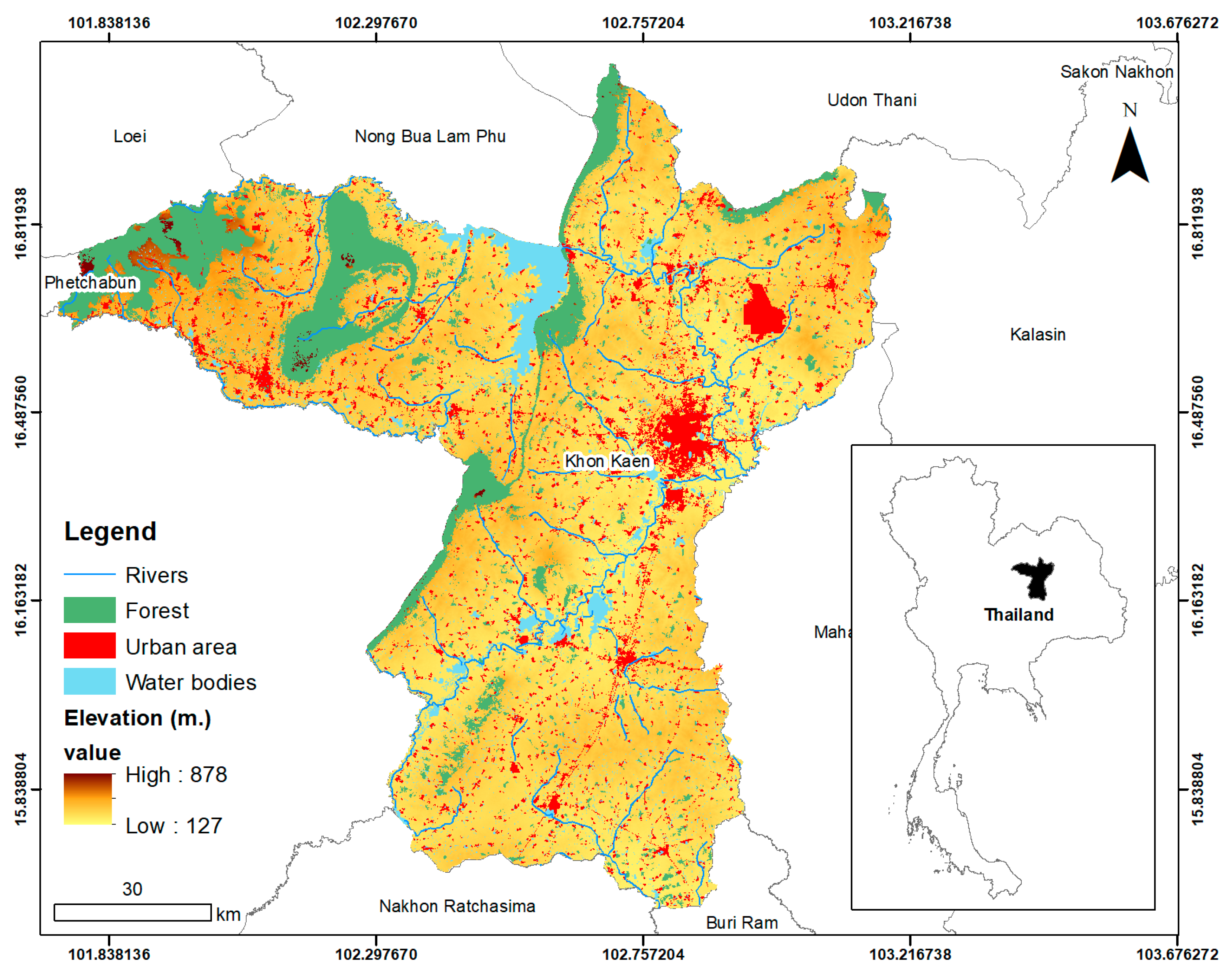
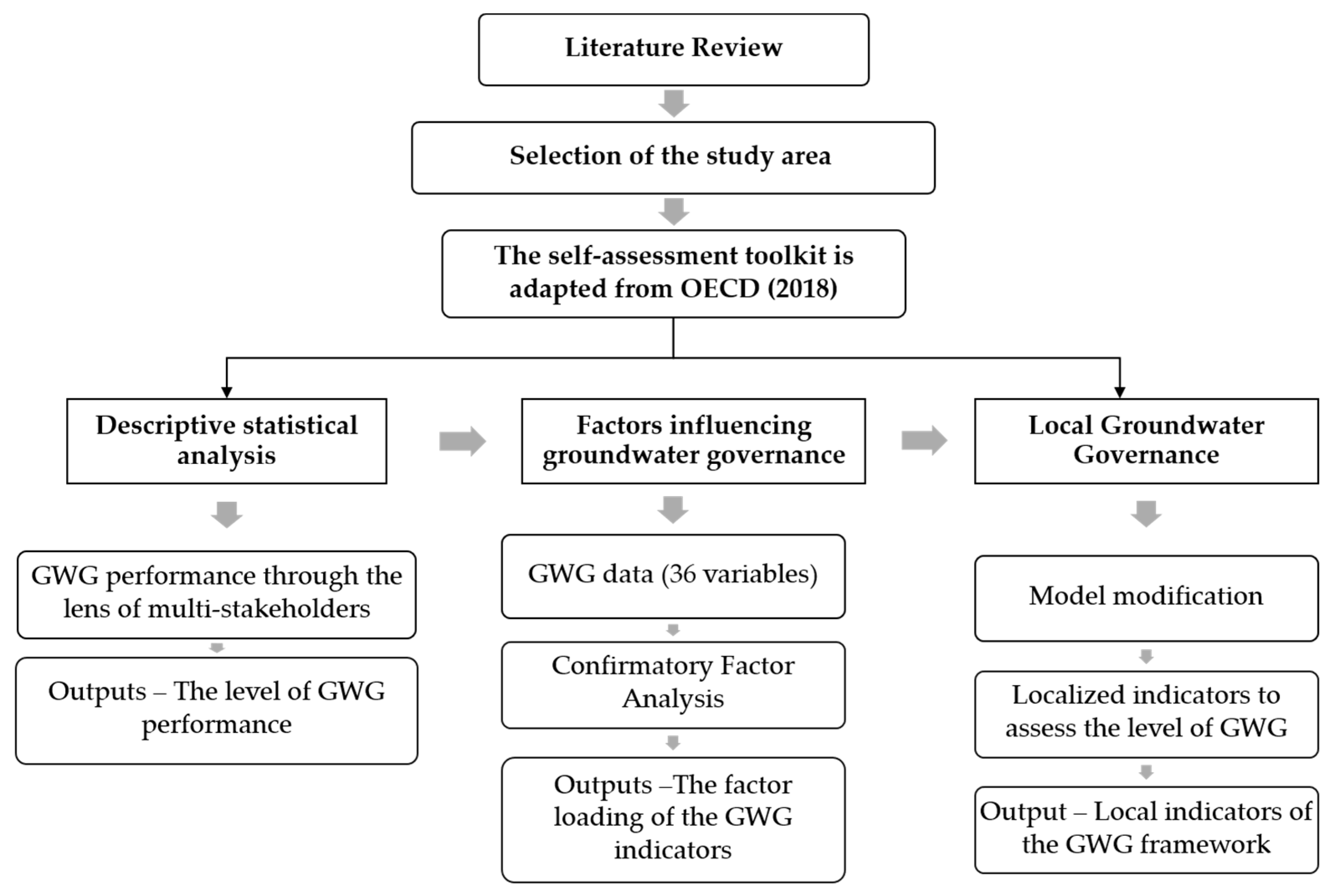
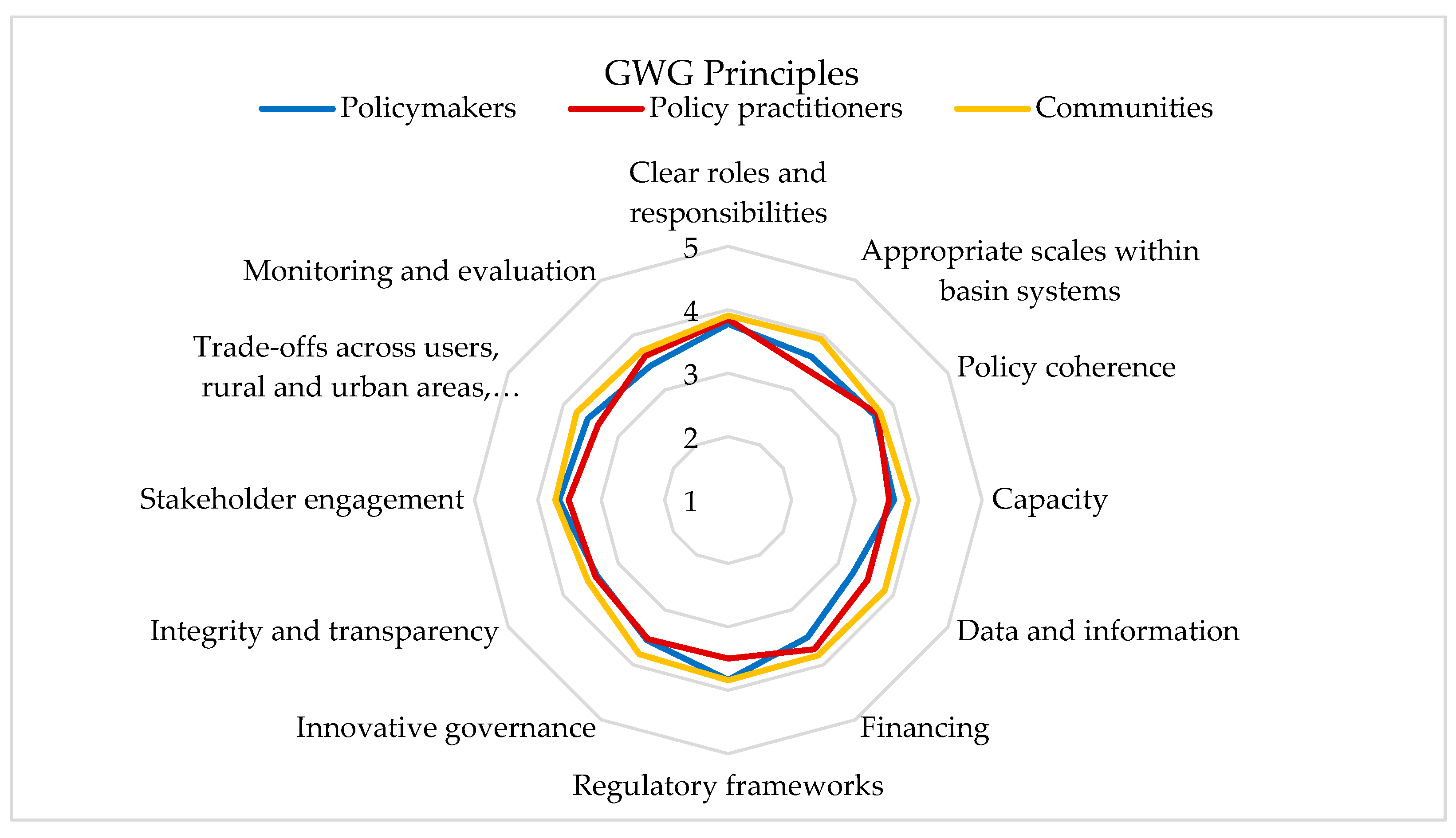
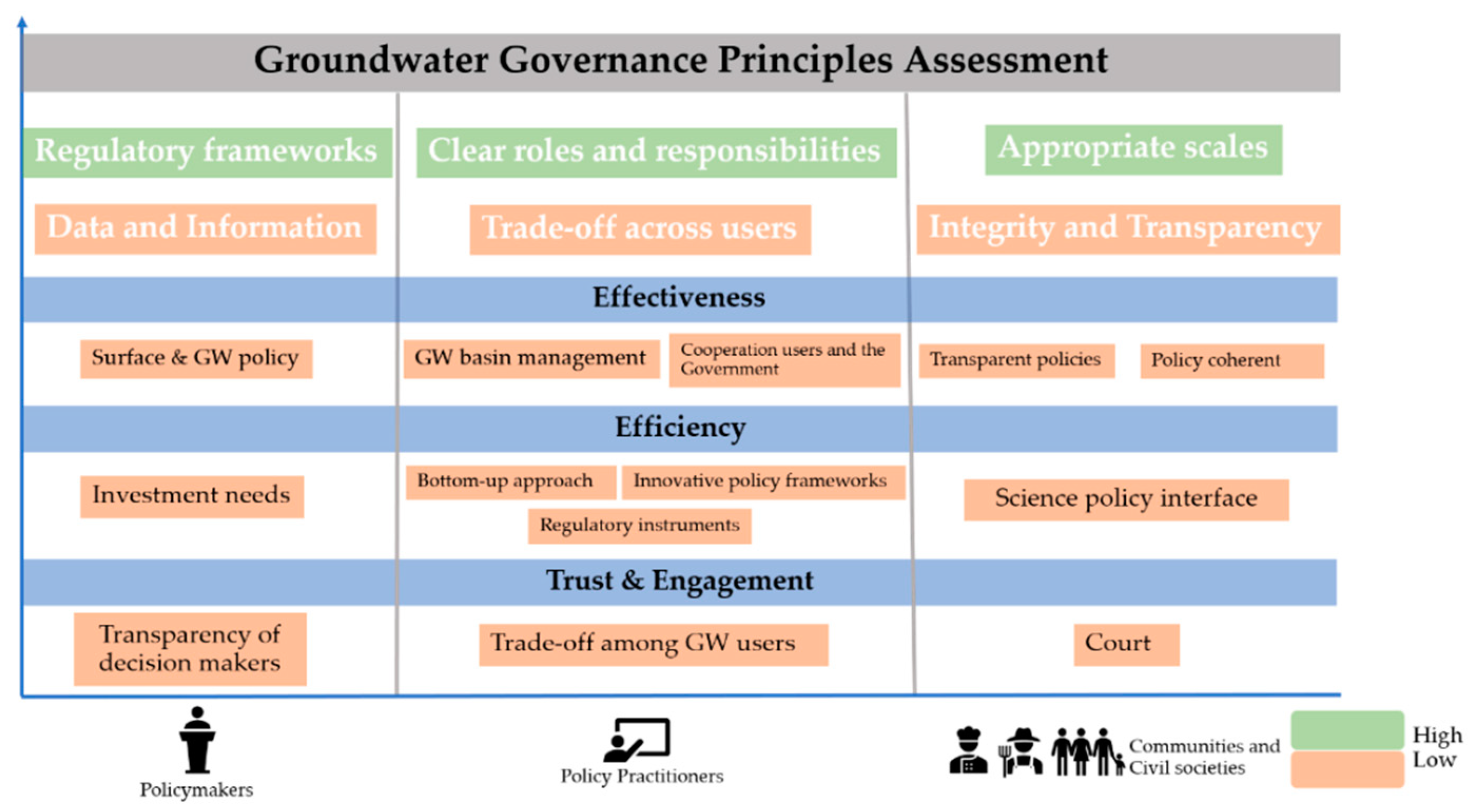
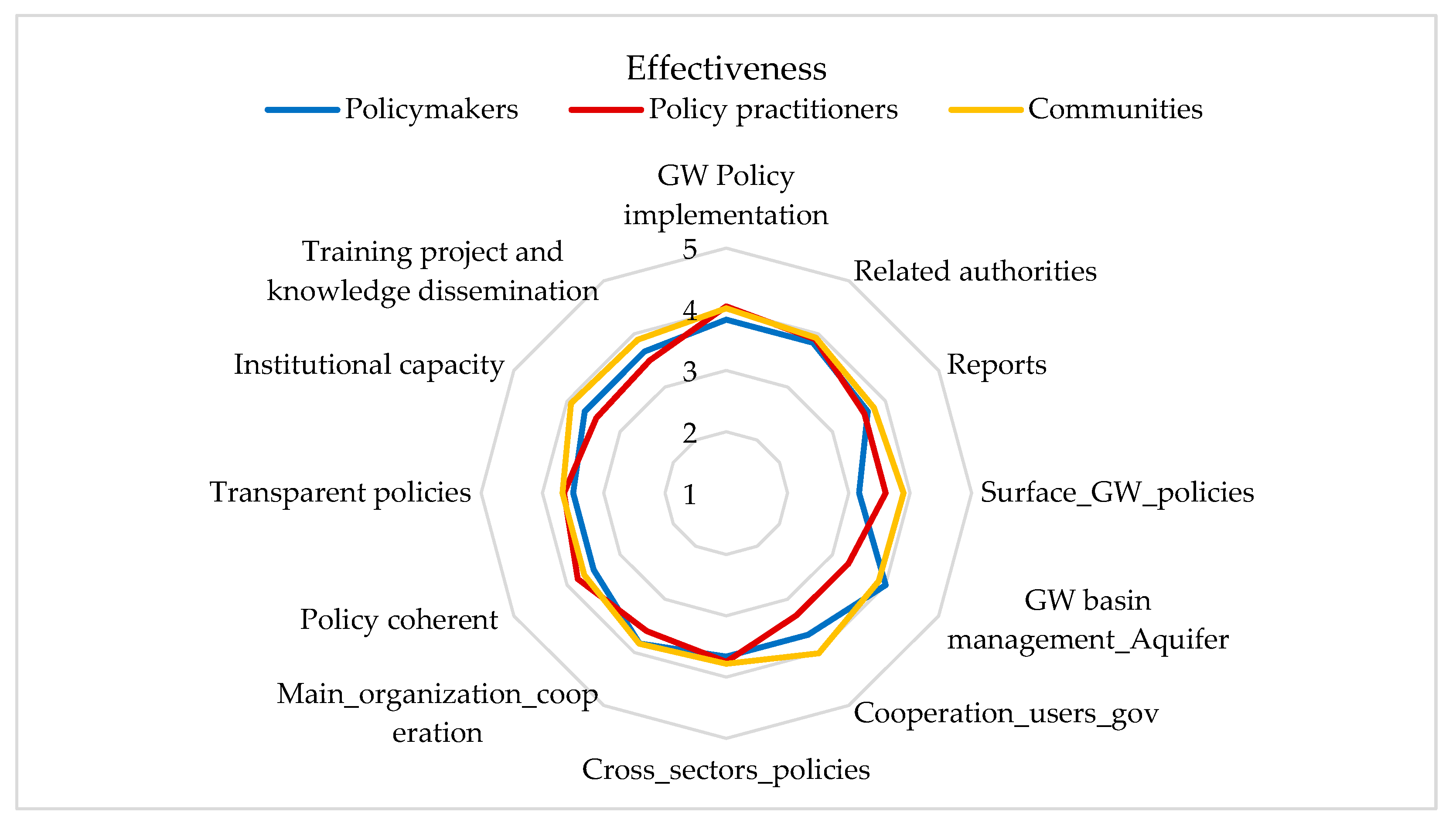
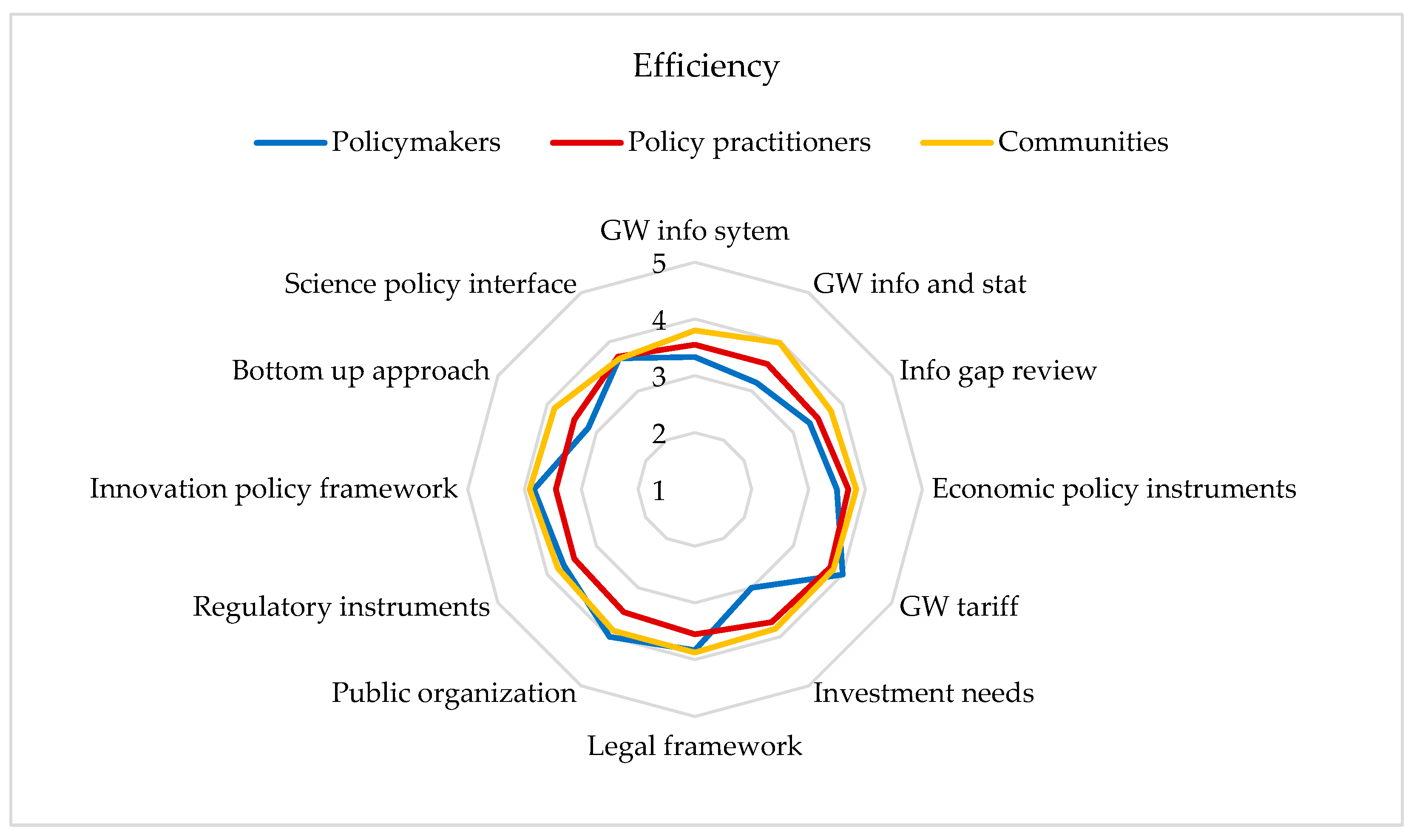
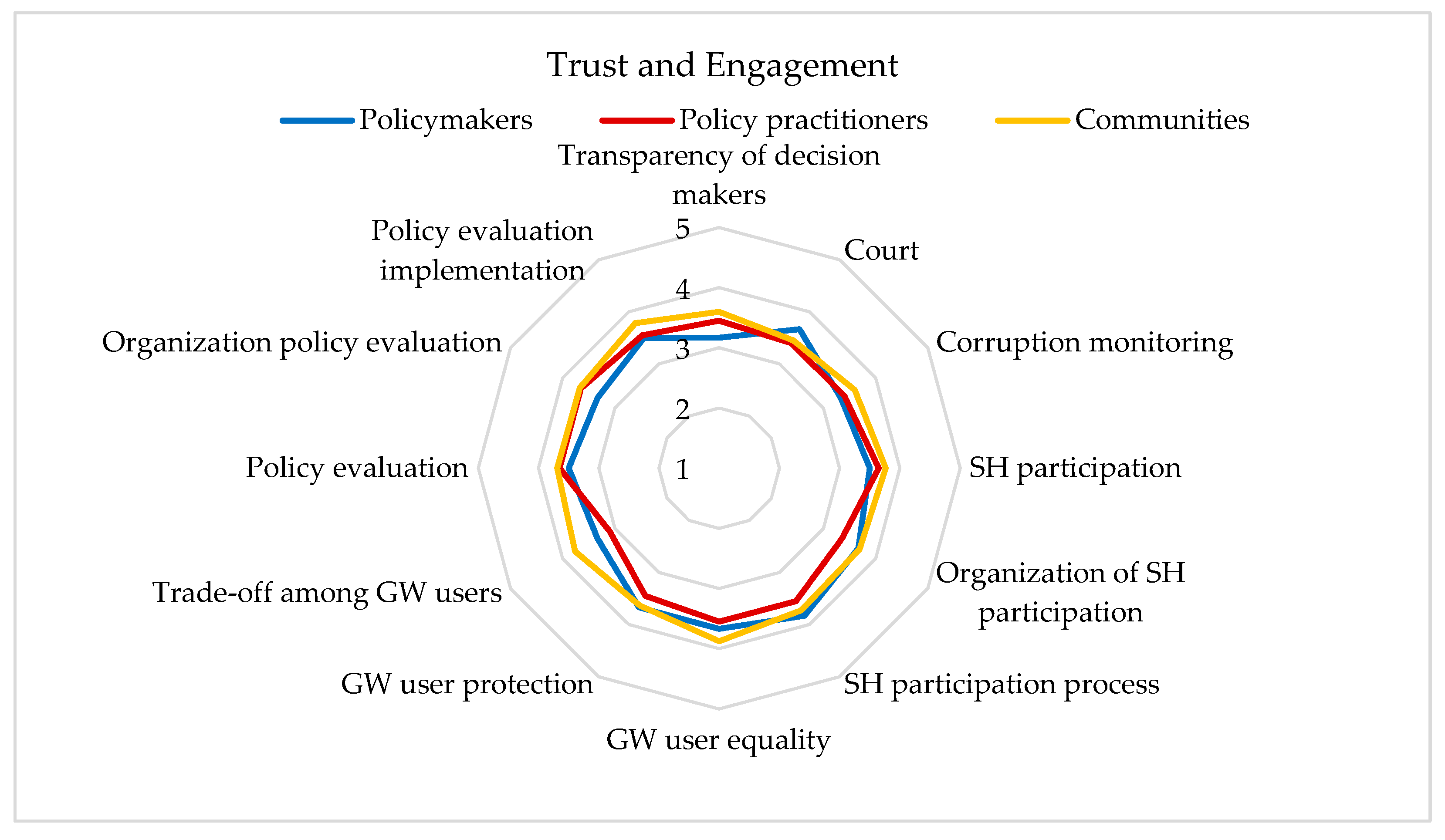
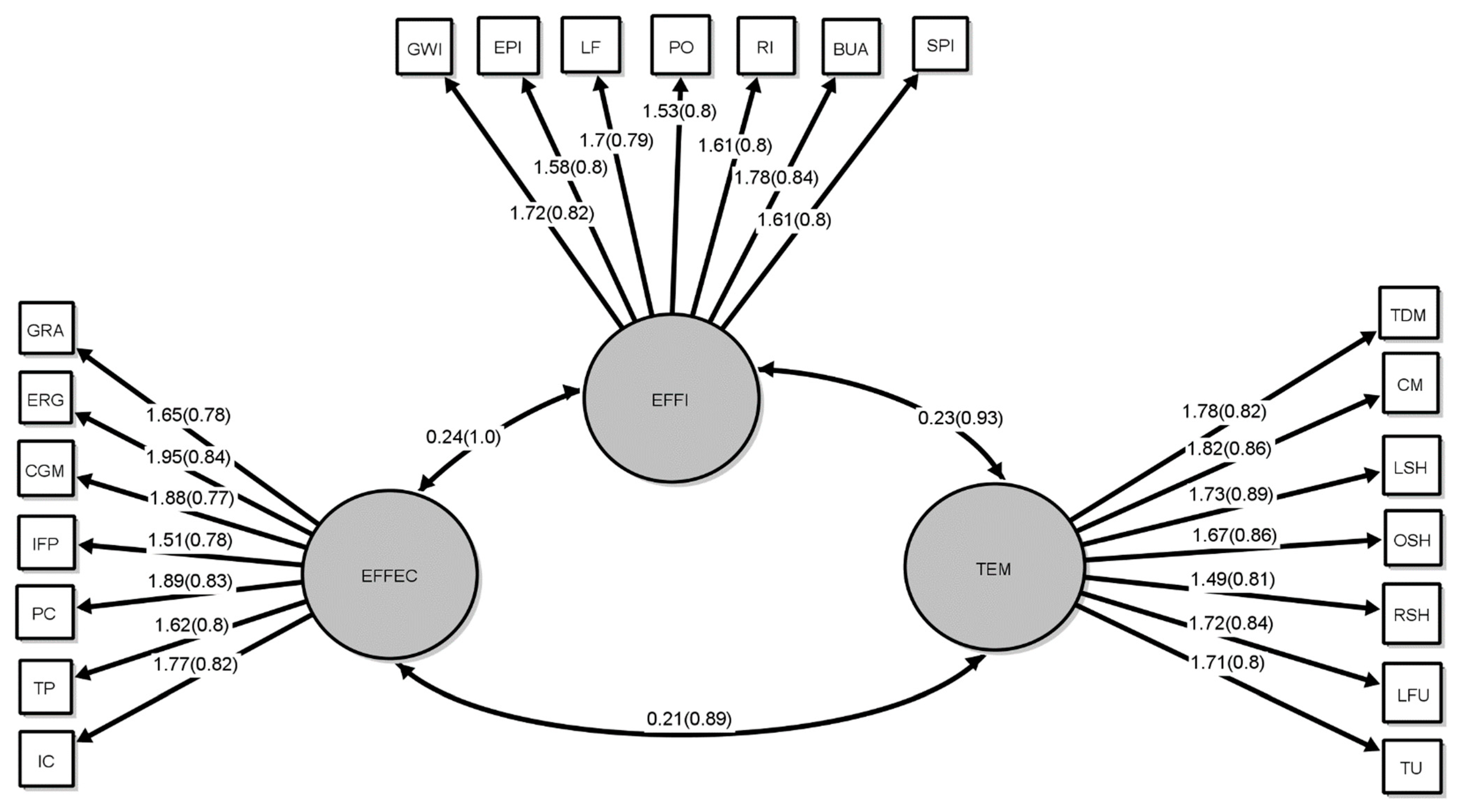
| Dimension | Observed Variables | Label | Standardized Factor Loadings (β) | Standard Error (S.E.) |
|---|---|---|---|---|
| Effectiveness | GW related authorities | GRA | 0.78 | 0.046 |
| Existing analytical reports about GW management | ERG | 0.84 | 0.032 | |
| Cooperation for GW management | CGM | 0.77 | 0.043 | |
| Institutions facilitated policies across ministries | IFP | 0.78 | 0.041 | |
| Policy coherence | PC | 0.83 | 0.037 | |
| Transparent policies | TP | 0.80 | 0.041 | |
| Institutional capacity | IC | 0.82 | 0.039 | |
| Efficiency | GW information systems | GWI | 0.82 | 0.037 |
| Economic policy instruments | EPI | 0.80 | 0.042 | |
| Legal framework | LF | 0.79 | 0.043 | |
| Public organization | PO | 0.80 | 0.042 | |
| Regulatory instruments | RI | 0.80 | 0.042 | |
| Bottom-up approach | BUA | 0.84 | 0.034 | |
| Science–policy interface | SPI | 0.80 | 0.040 | |
| Trust and Engagement | Transparency of decision makers | TDM | 0.83 | 0.039 |
| Corruption monitoring | CM | 0.85 | 0.032 | |
| Legal frameworks related to stakeholder participation | LSH | 0.89 | 0.025 | |
| Organization related to stakeholder participation | OSH | 0.84 | 0.032 | |
| Review stakeholder engagement challenges, processes, and outcomes | RSH | 0.81 | 0.040 | |
| Legal frameworks related GW user equality | LFU | 0.85 | 0.036 | |
| Trade-off across GW users | TU | 0.82 | 0.042 |
Publisher’s Note: MDPI stays neutral with regard to jurisdictional claims in published maps and institutional affiliations. |
© 2022 by the authors. Licensee MDPI, Basel, Switzerland. This article is an open access article distributed under the terms and conditions of the Creative Commons Attribution (CC BY) license (https://creativecommons.org/licenses/by/4.0/).
Share and Cite
Muenratch, P.; Nguyen, T.P.L. Local Governance of Groundwater Resources through the Lens of Stakeholders in the Context of State-Led Management in the Lower Mekong Region. Water 2022, 14, 3043. https://doi.org/10.3390/w14193043
Muenratch P, Nguyen TPL. Local Governance of Groundwater Resources through the Lens of Stakeholders in the Context of State-Led Management in the Lower Mekong Region. Water. 2022; 14(19):3043. https://doi.org/10.3390/w14193043
Chicago/Turabian StyleMuenratch, Preeyaporn, and Thi Phuoc Lai Nguyen. 2022. "Local Governance of Groundwater Resources through the Lens of Stakeholders in the Context of State-Led Management in the Lower Mekong Region" Water 14, no. 19: 3043. https://doi.org/10.3390/w14193043
APA StyleMuenratch, P., & Nguyen, T. P. L. (2022). Local Governance of Groundwater Resources through the Lens of Stakeholders in the Context of State-Led Management in the Lower Mekong Region. Water, 14(19), 3043. https://doi.org/10.3390/w14193043






